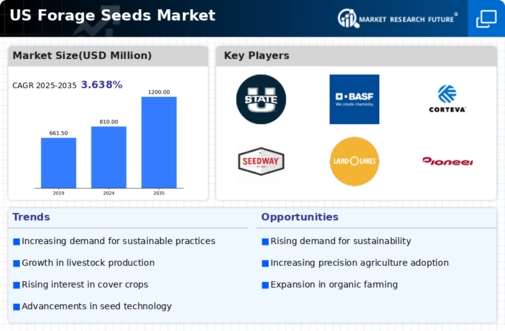Expansion of Organic Farming
The expansion of organic farming practices is a significant driver for the forage seeds market. As consumer preferences shift towards organic products, farmers are increasingly adopting organic methods, which require specific forage seed varieties. The organic forage seeds market is projected to grow at a CAGR of approximately 7% over the next five years, reflecting the rising demand for organic livestock feed. This trend is supported by government initiatives promoting organic agriculture, which further incentivizes farmers to transition to organic practices. Consequently, the forage seeds market is likely to see a surge in demand for organic seed varieties, aligning with broader trends in sustainable agriculture.
Increased Focus on Soil Health
Soil health is gaining prominence in agricultural practices, directly impacting the forage seeds market. Farmers are increasingly recognizing the importance of maintaining soil fertility and structure to ensure sustainable crop production. The use of cover crops and diverse forage species contributes to improved soil health, which in turn enhances the productivity of forage crops. Recent studies suggest that implementing these practices can lead to a 15% increase in forage yield, thereby benefiting the forage seeds market. As awareness of soil health continues to grow, the demand for specific forage seed varieties that promote soil regeneration is likely to rise, further shaping the market landscape.
Rising Demand for Livestock Feed
The forage seeds market is experiencing a notable increase in demand for livestock feed, driven by the growing livestock population in the US. As the agricultural sector expands, farmers are seeking high-quality forage to enhance the nutrition of their animals. This trend is reflected in the market data, which indicates that This trend is reflected in the market data, which indicates that it is projected to reach approximately $1.5 billion by 2026, with a CAGR of around 5.2% from 2021 to 2026. The need for nutritious feed is paramount for livestock health and productivity, thereby propelling the forage seeds market forward. Additionally, the rising consumer preference for organic and grass-fed meat products further fuels this demand, as farmers increasingly turn to forage seeds to meet these market expectations.
Climate Change Adaptation Strategies
The forage seeds market is increasingly influenced by the need for climate change adaptation strategies. As weather patterns become more unpredictable, farmers are compelled to select forage varieties that can withstand extreme conditions such as drought or flooding. This shift is prompting research into developing more resilient seed varieties, which is essential for maintaining productivity in the face of climate challenges. The market is witnessing a growing interest in native and drought-resistant forage species, which could potentially account for a larger share of the market in the coming years. This adaptation not only supports sustainable farming practices but also enhances the resilience of the forage seeds market against climate variability.
Technological Advancements in Agriculture
Technological innovations are significantly impacting the forage seeds market, as advancements in agricultural practices enhance seed quality and yield. Precision agriculture, for instance, allows farmers to optimize planting and harvesting processes, leading to improved efficiency and productivity. The integration of biotechnology in seed development has resulted in varieties that are more resilient to pests and diseases, which is crucial for maintaining crop health. According to recent data, the adoption of these technologies could potentially increase forage yield by up to 20%, thereby benefiting the forage seeds market. As farmers embrace these innovations, the overall competitiveness of the forage seeds market is likely to improve, attracting further investment and research.






















Leave a Comment